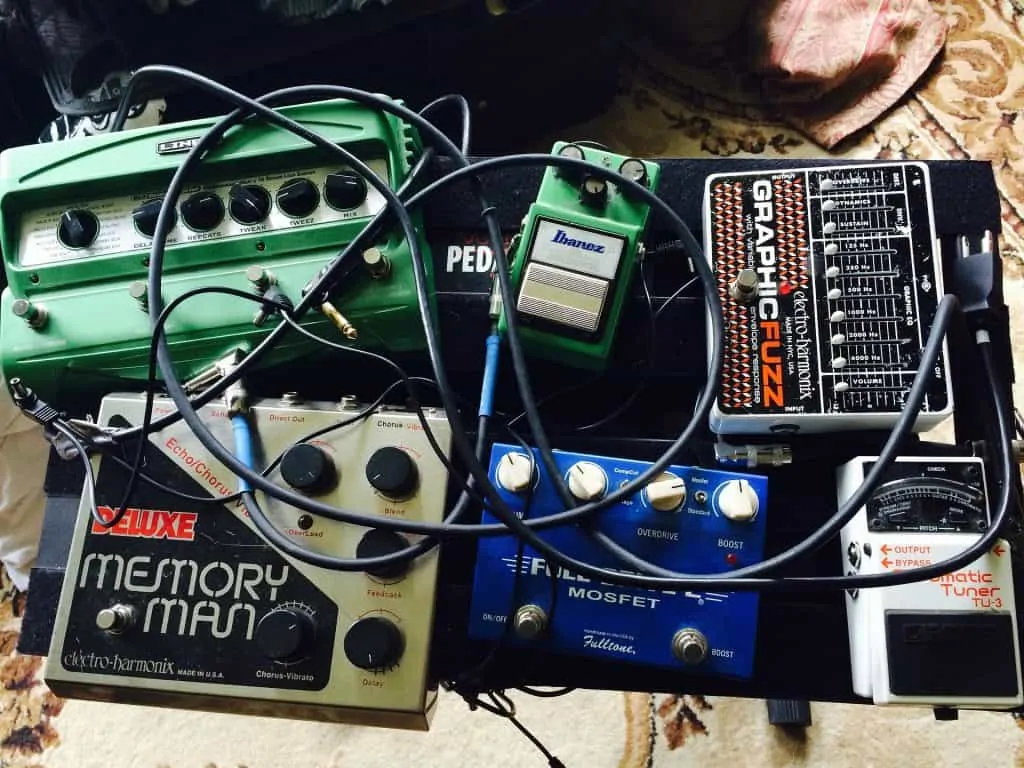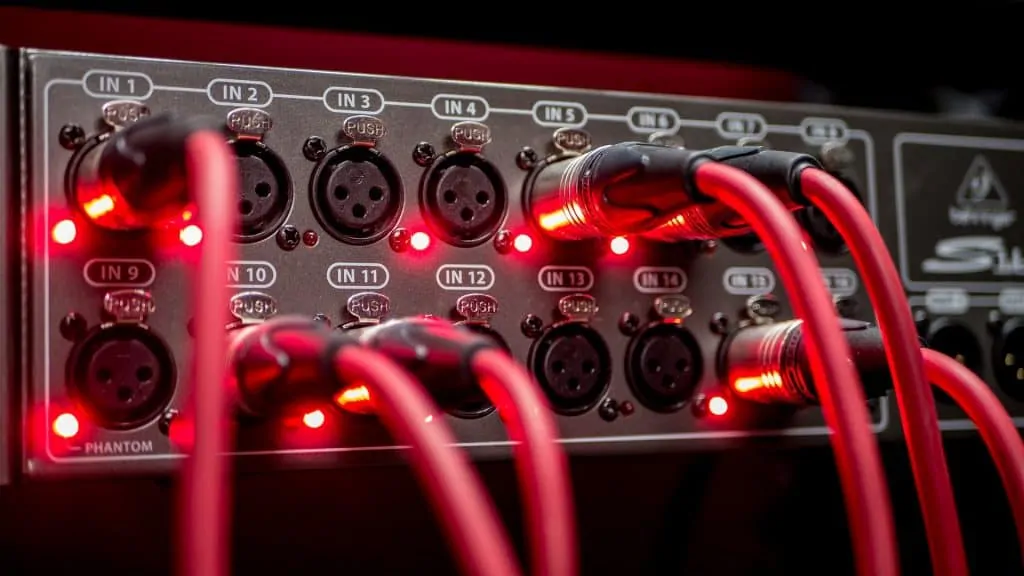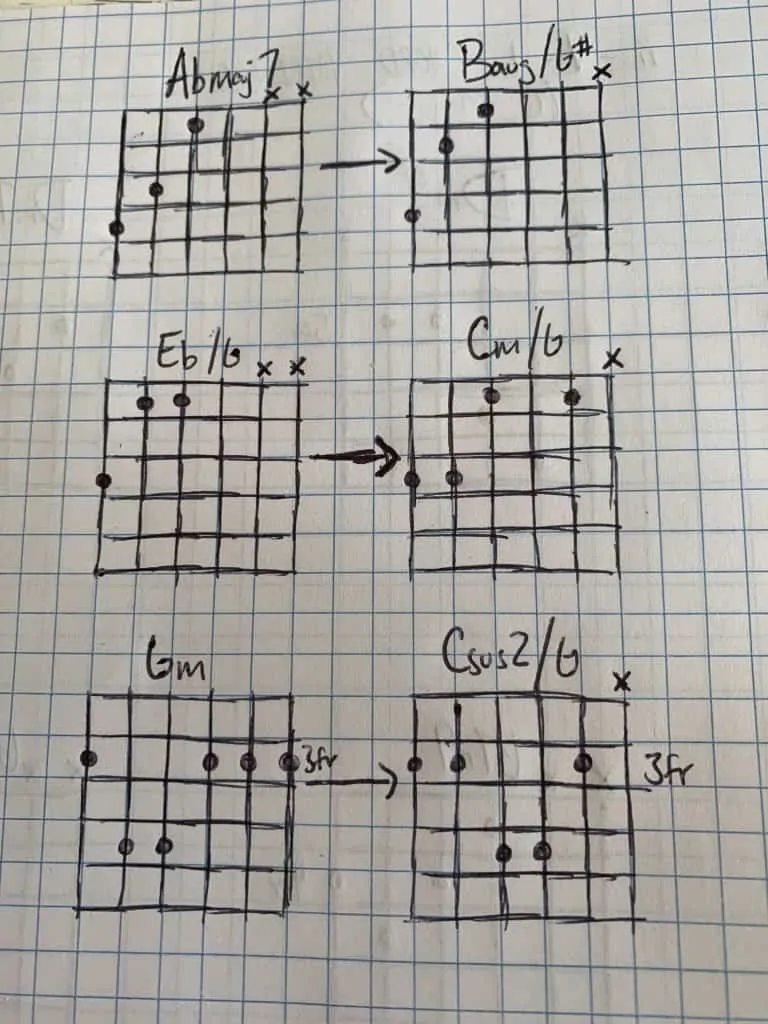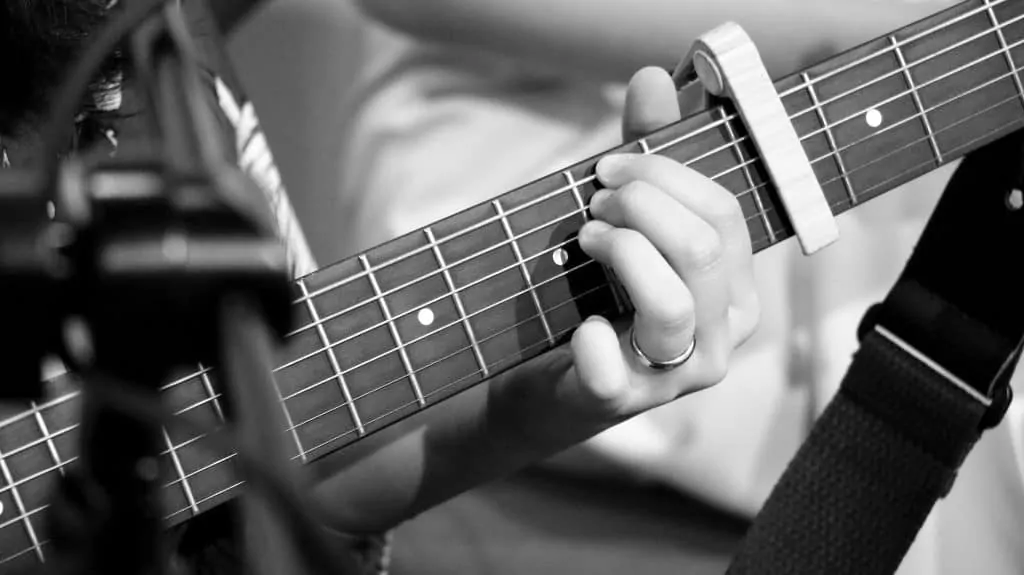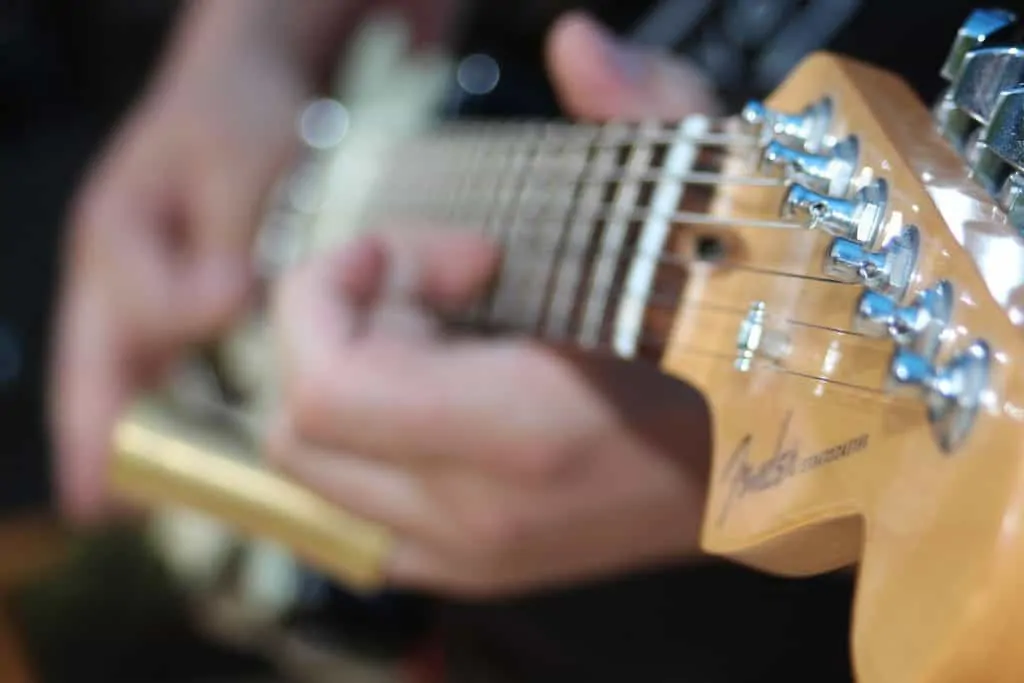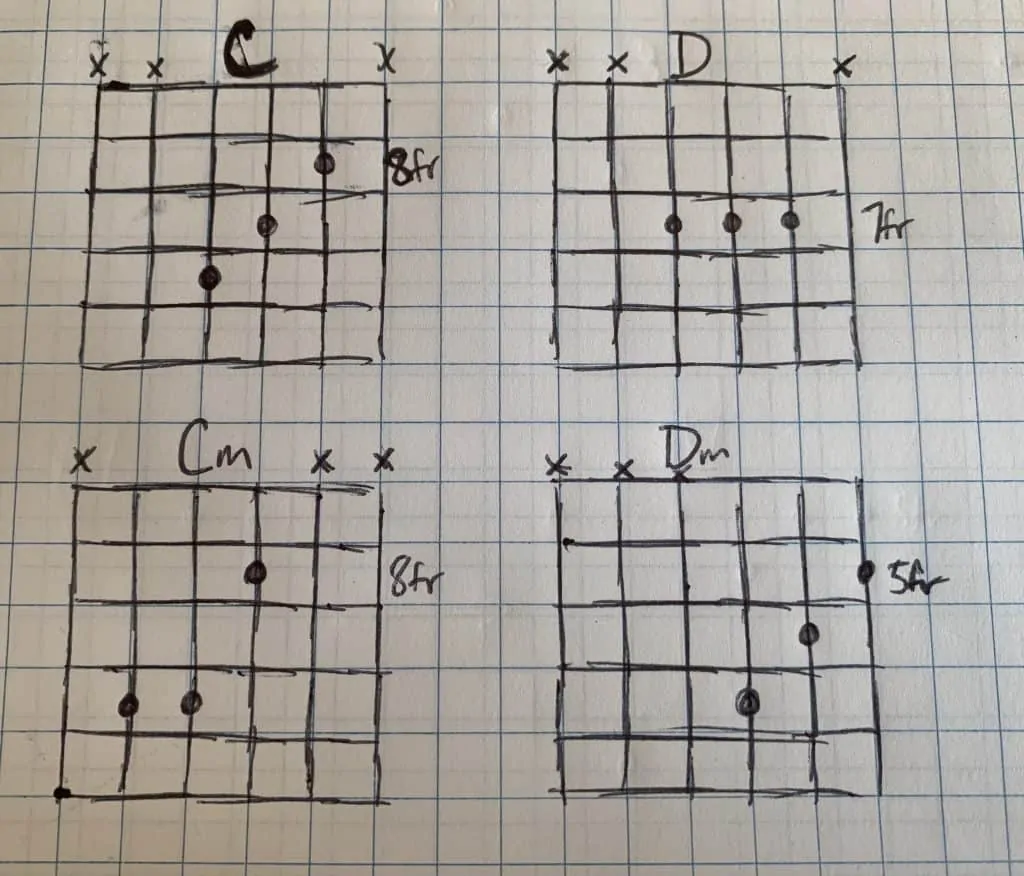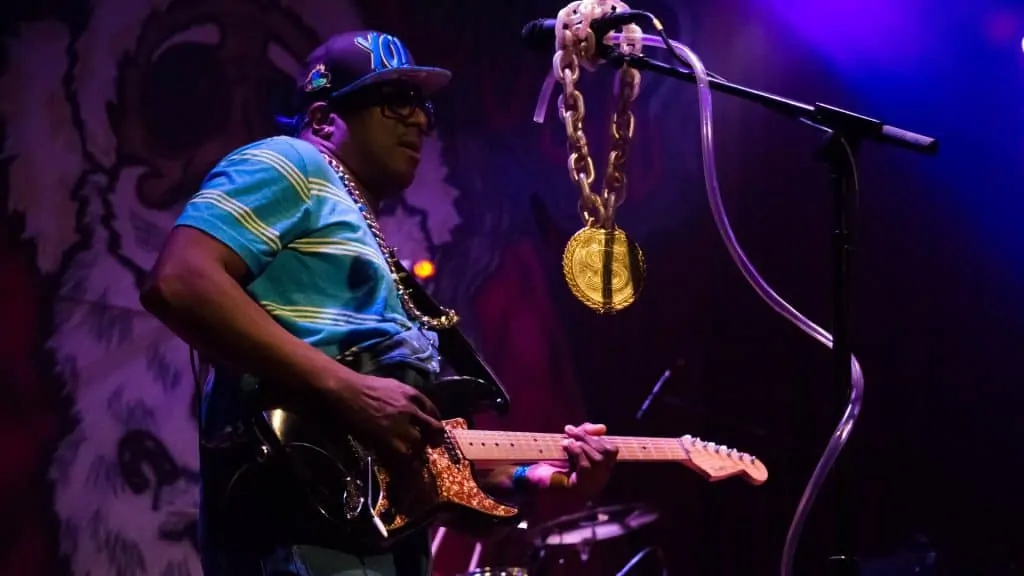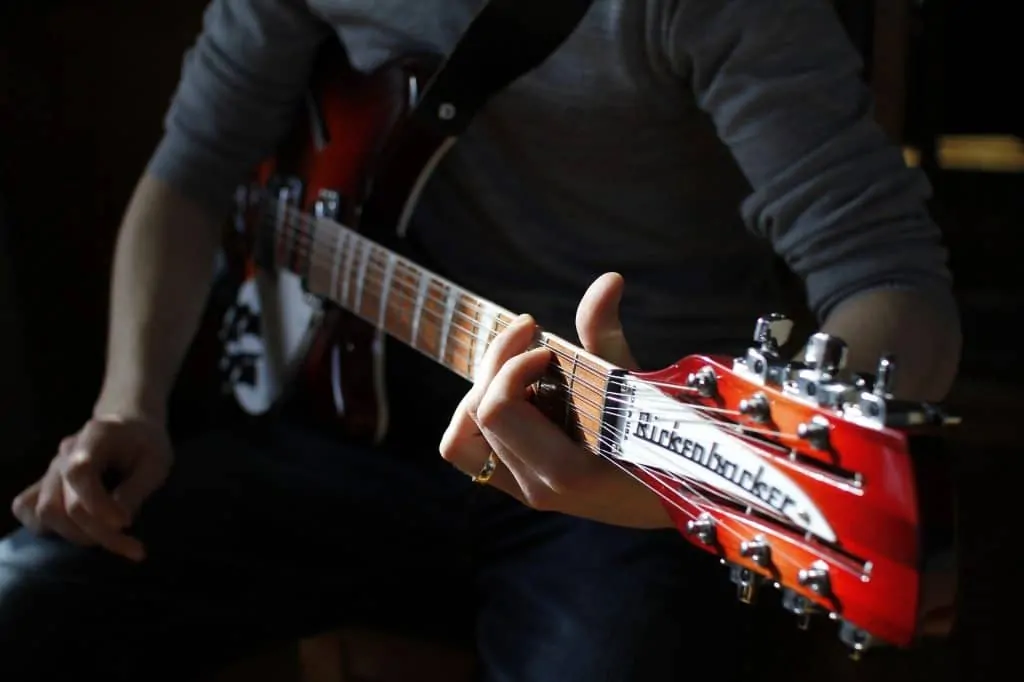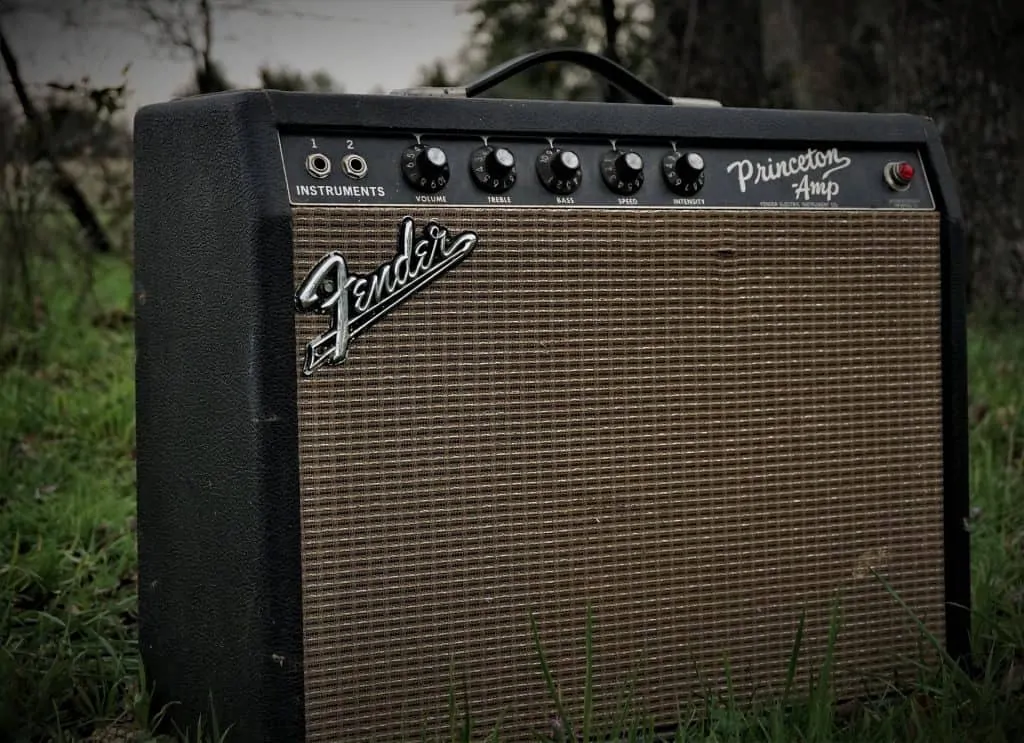“Indie music” may be a misnomer: while the term is labeled as one genre, the name encompasses an incredibly wide array of different artists, all with their own unique sound and playing style. Yet part of the beauty of indie music is embracing that diversity.
Learning to play indie guitar will expose you to more new sounds and techniques than nearly any other genre around. And the hallmarks of the genre — like broken, melodic chords, arpeggios, and chord-centered solos — can translate to a wide variety of different styles you may play.
Indie guitarists love to use effects pedals to change their basic guitar sound.
Contents
Characteristics of Indie Guitar
Indie music arose during the 1980s, a decade when guitar music was dominated by hair metal bands and extreme shredders in the mold of Yngwie Malmsteen. In reaction, many indie guitar players deliberately adopted a mindset counter to the rapid-fire, solo-centric approach to the guitar flooding the airwaves at the time.
Indie guitar playing is fundamentally based on a strong grasp of melody, creative chord choices, lots of broken chords and arpeggios substituting for barre chords in rhythm playing, and a distinctive lack of both classic-rock distortion and high-octane solos.
Beyond the music, many indie guitarists (and bands as a whole) deliberately eschewed the spotlight in favor of retaining some measure of artistic integrity. Though indie bands still became widely popular — and many “sold out” at the same rate as their mainstream counterparts, altering their sound to produce more commercially viable records — the anti-guitar hero ethos continues to influence indie players today. In fact, Johnny Marr even famously wrote a set of “Ten Commandments” on how to avoid becoming a guitar hero!
Nowadays, many of those “rules” have loosened — no surprise, considering indie music was originally a genre about breaking the conventional rules of rock when it was invented. Modern indie guitar headliners like St. Vincent routinely play complex improvised solos drenched in waves of fuzz, and the arpeggiated, flowing style of pioneers like Marr has been tempered by the hard-driving influence of the alternative rock scene.
But if there’s one critical thing to keep in mind about playing indie guitar beyond the technique, it’s the mindset: innovation, and commitment to the new and artistic over the commercial and popular.
U2 guitarist The Edge incorporated techniques from indie players like Johnny Marr into his band’s work throughout the 1990s.
Famous Indie Guitar Players
Any discussion of indie guitar players begins and ends with Johnny Marr, the legendary guitarist of all-time indie greats like The Smiths, The The, and Modest Mouse. In many ways, his intensely melodic style has shaped the evolution of the genre. And while indie music continues to adapt, Marr is largely responsible for creating indie’s signature guitar sound and will always belong at the top of any list of famous indie guitar players.
Another large presence on the indie rock scene throughout the 1980s and 1990s was New York City band Sonic Youth. Their twin guitarists, Lee Ranaldo and Thurston Moore, pioneered the use of alternative tunings in indie rock and became famous for their habit of playing the guitar with random objects from drumsticks and violin bows to screwdrivers.
While their use of so many indecipherable tunings and custom-prepared instruments may be nearly impossible to replicate, their sound remains a major influence throughout indie music today.
Coming onto the scene slightly after Marr’s tenure in the Smiths ended, guitarist Joey Santiago moved the indie genre forward with his work in the Pixies. While he took and built upon Marr’s use of melody and arpeggios, Pixies music displays a much harder, more aggressive side of the indie genre, more in line with hard-nosed punk and hard rock than with Marr’s shimmering, ethereal chord structures.
Santiago’s trademark stripped-back chord structures and lean solo lines would later inspire genres like grunge, particularly through his influence on Nirvana frontman Kurt Cobain. The use of distortion and fuzz in 90s bands like the Pixies and Nirvana also changed the sound of indie from a clean, broken-chord sound to a rawer format focused around the use of power chords.
In the modern era, indie guitar has found a place among an increasingly large array of synthesizers and effects. Artists like St. Vincent have integrated a fuzz guitar sound into electronic-based pop arrangements, while Tame Impala’s Kevin Parker has meshed indie guitar sounds with psychedelic vocals and effects.
Indie guitar often incorporates multiple chords and melodies tracked over each other.
Chords and Melody
One consistent trend throughout the history of indie guitar is the use of chords and melody. In classic rock bands, there’s typically a hard delineation between the lead and rhythm guitar players — the rhythm player maintains the groove with basic barre and open chords, while the lead player provides all the accents and plays the solos. Indie guitar, on the other hand, fuses those two identities into one player.
Rather than playing jaw-dropping solos like a blues or rock guitar hero might, indie players are challenged to integrate the song’s melody into their rhythm playing and add main riffs and accents to a tune while maintaining the pulse.
Because of these multiple jobs, indie songs often feature riffs based heavily around chords and break up the chords themselves into more melodic voicings. Rather than the power chord, featuring just the root and fifth notes on the bass strings, indie players make greater use of the top strings, especially for playing inversions of various chords in positions higher up the neck.
For an example of a classic melodic indie rhythm part, check out the video above of The Smiths’ debut single, “Hand in Glove.” Widely considered to be one of the first true indie songs, “Hand in Glove” is as notable for its interwoven guitar rhythm and melody as it is for Morrissey’s provocative lyrics. The opening riff, tabbed out below, is based entirely around the Bm chord that forms the basis of the song.
While “Hand in Glove” was recorded in the key of G (using a capo on the third fret), The Smiths often played it live in the key of F#, as it’s tabbed out here. Johnny Marr often tuned his guitar strings up a full step, but it’s easier to simply place a capo on the second fret if you want to avoid the hassle.
When searching for a melody or solo idea, many indie artists simply look to the song’s basic chords and make minor extensions off that central structure.
Depending on the style, indie songs can use a variety of different chords. Like more general rock, four-chord progressions are popular — especially a few stock ones that crop up everywhere.
The Pixies’ “Here Comes Your Man” utilizes a I-V-ii-IV progression, for example, while The Smiths’ “There Is A Light That Never Goes Out” uses the i, III, VI, and VII chords. Johnny Marr was also a big fan of the classic I-vi-IV-V progression, using it in both “Some Girls Are Bigger Than Others” and “Vicar in a Tutu.”
Many indie songs employ a simple overall chord structure with lots of subtle changes throughout to keep listeners on their toes. While the St. Vincent song “Los Ageless” contains a dizzying array of different chords at first glance, nearly all are formed by simply adding or removing one finger to move between the changes. From Abmaj7 to Baug/G#, Eb/G to Cm/G, or Gm to Csus2/G, St. Vincent skillfully creates larger harmonic shifts out of minor fingering tweaks.
Diagram of the chord changes through the outro of St. Vincent’s “Los Ageless.” Notice how simple one-note shifts can create a more drastic change in the character of each chord.
To create a set of chord changes, you might try simply adding an extra extension to a classic barre-shape chord, removing one of those fingers to let an open string ring out, or shifting some of your fingers up and down by one fret. Playing around with these minor changes will increase your familiarity with different chord roots and extensions and can give you ideas for potential solos.
Indie guitar chords tend to revolve around the guitar’s upper strings — when power chords and full barre chords are used, they tend to be palm-muted and quick. There are certainly exceptions in a genre as diverse as indie, but on the whole quick, sharp rhythm parts are more common than heavy, ringing bass strings. Extended chords on the upper strings also allow for more richly colored chord structures without contorting your fingers into twister-style positions.
Capoes are a common tool in indie rhythm guitar to change the key of a song.
Rhythm
Indie music generally operates in a straight 4/4 feel, with steady but not flashy drumming. As a guitar player, that style makes it much easier to lock into the groove, but also puts more onus on the guitar to create an interesting groove. Syncopation and proper use of space are critical skills for any indie guitarist to learn.
Economic playing is a much more important trait in indie music than in formats like jazz and blues-based rock. The primary goal is to convey the essence of the melody and rhythm in ass methodical a way as possible. That doesn’t mean you should resist fleshing out a particular groove; just remember not to bury the lead by drowning out the melody and pace in an overly crowded mix.
Incorporating the melody prominently in your rhythm part is a great way to guard against overly busy playing. If you find yourself struggling to nail the melody notes because of a complex strumming pattern or additional chord flourishes, take a step back and analyze which parts are truly necessary and which are just providing white noise.
If you’re playing indie music with another guitar player, feel free to split the rhythm strumming between you for a stronger, more syncopated feel. Depending on your skills, it can also be common to have one player hold down a steady rhythm to set the pace and have the other guitarist play on off beats or in funky time subdivisions (like triplets) to get the track swinging.
Thankfully, indie songs tend to not be too fast. Though some parts may be very complex, and even the initially easy guitar lines can be extremely difficult to master, indie is a largely straightforward genre for beginners to pick up and play. For the most part, there are no blast beats or burning fast passages to be found.
Arpeggios and triads are in many ways a defining feature of indie guitar.
Arpeggios and Triads
Beyond just playing broken chords, indie guitarists love to use arpeggios and triads in their rhythm parts.
Interspersing arpeggios with strummed chords livens up rhythm parts and forms a more interesting counterpoint to many singers during breaks between vocal lines. If you’re changing chords quickly, arpeggios are also a great “shorthand” to give the flavor of a full chord with just a couple notes.
For strummed, consistent parts, chord triads can be a particularly helpful tool. These groups of three notes (hence the name) contain the root, third, and fifth of each chord without repeating any one — technically, chords like Am, C, G, and Dm are all basic triads. However, plenty of triads exist further up the neck, and without any open strings to fill out the sound.
Some common indie voicings for major and minor triads.
Major triads are constructed from the root, major third, and fifth of a given chord. Think of them like miniature slices of a fuller major chord; most of them are just three strings picked out from a major barre chord in the same positions.
Minor triads, meanwhile, use a minor third along with the root and fifth (rather than a major third). In the same way as major triads, many minor triads beyond the open position are simply chunks of three notes taken from minor chord barre shapes. Look at the diagrams above for a few common examples of major and minor triads.
Major and minor triads are by far the most common triads you’ll find in indie music. However, you can also use less common diminished and augmented triads for a different sound. Diminished triads, made from a root, flat third, and flat fifth, give a darker, jazzier sound. Augmented triads, meanwhile, are built with a root, third, and sharp fifth and sound brighter and more open than other triads.
Whether played together or picked out note by note, triads provide the central character of a chord without much of the booming, thick bass. They’re a great way to keep your guitar part snappy and ensure it can cut through your mix; as an added bonus they’re also much easier to fret than chunky barre chords and allow you to add extra extensions with your little finger!
Solos in indie guitar heavily incorporate arpeggios and chord shapes.
Solos (Or Lack Thereof)
Indie guitar solos are a hotly debated topic, and different players hold vastly different opinions on both their validity and suitability for the indie genre. While guitar solos have historically been uncommon in indie rock — and the solos that did exist were designed to echo the song’s melody rather than set the stage for individual improvisation — modern artists have re-imagined and popularized the concept of solos in the indie field.
At the inception of indie music in the late 1970s and early 1980s, improvised pentatonic solos were ubiquitous in pop and rock. In deliberate contrast, solos of any nature are exceedingly rare on early indie records, and improvised solos rarer still. Far more common are the guitar breaks in tunes like The Smiths’ “Bigmouth Strikes Again” — just as the song is centered around a C#m chord, the solo (tabbed below) is just a repeated lick based off of a C#m arpeggio with some chromatic notes thrown in.
The solo is much easier to play with a capo on the fourth fret (as Johnny Marr performed it). Simply keep your hand in an Am chord position and use your pinky to hit the fretted notes outside of the chord shape. Marr plays the solo at a fast clip on the record — listen carefully to pick up the rhythm and the minor variations!
Sonic Youth’s hit “Kool Thing” features a similarly repetitive solo section, fueled more by rhythm and tempo than by inventiveness or playing dexterity. That’s not to imply that simple solos are necessarily bad — indeed, both of those solos above are practically perfect for each respective song and certainly serve the tune as a whole much better than any improvisational jam break could have. Respecting the needs of the song above the cool factor of any solo is the best way to write an effective indie guitar solo.
In a more unique approach, some indie tracks also feature instrumental sections with a combination of single-line and chordal soloing. Johnny Marr is a master of this technique as well, with stand out examples on Smiths tracks like “Heaven Knows I’m Miserable Now,” “Nowhere Fast,” and “How Soon is Now.”
As indie has grown to include more distortion and fuzz and song structures have shifted, guitar solos have become more adventurous. St. Vincent, for example, regularly plays avant-garde solos dripping with gain in her live shows. While blues soloing is still rare, and jazz soloing generally doesn’t fit in the shorter instrumental breaks, there are fewer limits than ever to indie guitar solos.
To construct an indie solo, you should base your line ideas off of chord tones and arpeggios, with some chromatic passing notes thrown in for an edgier feel. Emphasize feel and groove over speed, as many indie solos are simply made of one lick repeated through the whole section. Ripping off a pentatonic or modal improvised solo would simply sound out of place over an indie rock track.
Rickenbacker guitars, especially 12-string models like this one, are popular among indie players.
Classic Indie Guitar Models
Throughout the genre’s history, indie guitarists have favored lots of different models. A few specific guitars, however, have set themselves above the rest for playing indie music.
Though Rickenbacker guitars were first made famous by 60s bands like the Beatles and the Byrds, early indie musicians quickly adopted Rickenbacker models like the 330 and 360 for their ringing, treble-heavy sound. In contrast with the thicker, humbucker-equipped Gibson guitars favored by blues and rock players, the distinctive necks on Rickenbackers are better suited for delicate broken chordal playing and resist bassy, bend-heavy playing.
With players like Johnny Marr and Peter Buck of R.E.M., Rickenbackers quickly rose in popularity, leading up-and-coming indie guitarists to look for their own sound in different models. One of the most popular was the Fender Jaguar; it retained the Rickenbacker’s clean tones but added some versatility in the form of its different tone circuits and solid-body Fender design.
The Jaguar, along with its offset brother the Jazzmaster, dominated the sound of many indie bands in the 1990s and beyond. Starting when Thurston Moore and Lee Ranaldo adopted the Jaguar and Jazzmaster for use in Sonic Youth, offset guitars rose in popularity on the indie scene.
Their influence extended beyond just indie, with grunge players like Kurt Cobain and shoegazers like My Bloody Valentine’s Kevin Shields picking up offset models as well. After joining Modest Mouse in the mid-2000s, indie originator Johnny Marr began collecting vintage Jaguars. That interest culminated in the release of his Fender Johnny Marr Signature Jaguar in 2012.
Another modern guitar well-suited for playing indie music is St. Vincent’s signature Ernie Ball Music Man model.
While the mini humbucking pickups offer a heavier sound than the single coils found in both Rickenbacker guitars and Fender offset axes, the model has won praise among the indie community for its versatile clean sound, ability to handle high levels of gain, and space-age style.
Vintage Fender units of amps like this Princeton are some of the most prized models for playing indie guitar
Tones and Effects
To achieve that prized treble tone, many indie guitarists set the EQ of their amps to favor the treble and cut out midrange and bass frequencies. Fender amps, especially blackface and silverface reverb models, became popular for their scooped mid signatures and outstanding clean tones.
Early indie guitar is recognized mostly for its use of chorus and delay. While in many ways these effects were more trademarks of 80s guitar music in general than exclusive indie sounds, guitarists like Johnny Marr and Peter Buck of R.E.M. loved to use chorus for a lush, rotating speaker-esque tone. The Boss CE-2 is the prime indie chorus effect, though the Roland JC120 amplifier was another source for guitarists to get their chorus sound.
As distortion and fuzz grew more popular, indie guitarists took inspiration from the alternative rock scene. Stompboxes like the Electro-Harmonix Big Muff series were prized for their searing, aggressive fuzz sounds.
Compression is another tool many indie players use to focus their signal and introduce a touch of dirt without the coloration of a fuzz or distortion pedal. Indie compression sounds can be heard on hits like Modest Mouse’s “Dashboard,” with its precise, cutting guitar lines.
Indie guitarists must develop a broad skill set to play effectively.
Summary
Despite the broad nature of the umbrella term “indie music,” the genre contains some of the most fascinating music of the past 30 years, and features a cadre of young, innovative guitarists performing on the scene today.
Learning how to play indie guitar may look different based on your personal taste within the style, but the traditional indie mindset and approach to the instrument remain applicable no matter your preferences. Honing your indie skills will also position you well for writing original songs, and make you a hit at jam sessions which prize strong accompaniment skills.
As you develop your indie guitar skills, pay close attention to your use of broken chords, arpeggios, and melody; maintain a strong sense of rhythm and restrain yourself from breaking out long blues-based solos whenever you can. Once you’re familiar with the genre, you can do the most classically “indie” move of all: break all the rules.
